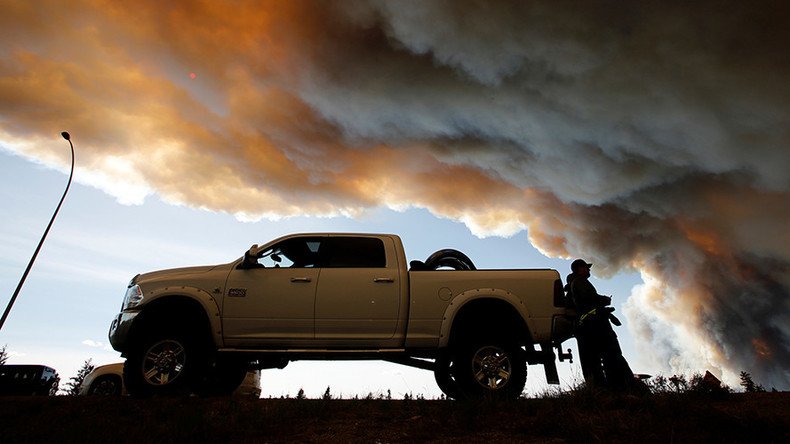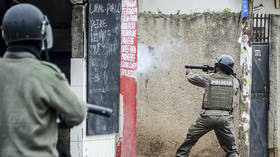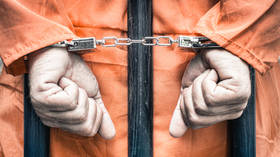7,000 airlifted out of Alberta inferno as officials warn blaze could double in size (VIDEOS)

Some 25,000 Canadians that fled north from Fort McMurray are reliving the horror of hastily evacuating through blazing forests, as thousands are now being forced to drive south or take rescue aircraft out. Meanwhile, the fire may double in size in a day.
The gargantuan fire is currently raging through 101,000 hectares of land, senior wildfire manager Chad Morrison told reporters on Friday. Temperatures are expected to reach 27° Celsius on Saturday, which could double the size of the fire by the end of the day, Morrison added.
There are still thousands of evacuees hiding out in oil sands work camps north of the city that need to be moved as soon as possible, officials warn. Luckily, many of these camps have runways for small aircraft, which have been used to evacuate some 7,000 people already. At least 5,500 more will be airlifted out later on Friday.
This spot near Fort McMurray has continued to spew swirling smoke all day with no end in sight. #ymmfirepic.twitter.com/EeEBbuG9V8
— Courtney Theriault (@cspotweet) May 7, 2016
A convoy of as many as 1,500 cars has also been trying to escape south to Edmonton via the highway passing through Fort McMurray. The first attempt failed, according to mounted police escorting the vehicles, as the drivers were faced with 60-meter-high (200ft) walls of flame raging on the sides of the road.
“We have stopped due to heavy smoke,” said Sergeant Jack Poitras of the Royal Canadian Mounted Police. “You get flames of 100, 200 feet up in the air on both sides of the road, so it’s not safe.”
‘Apocalyptic’ wildfires: people & beasts escaping #FortMcMurray inferno (dashcam vid) https://t.co/863LrIvd9Zpic.twitter.com/Y0EY9NK8pj
— RT (@RT_com) May 6, 2016
However, some 1,200 vehicles finally managed to pass the inferno by late Friday afternoon, AP reported.
It could take up to four days to move everyone out, according to officials.
The total number of people that have fled Fort McMurray and nearby residential areas since Tuesday could now amount to well over 90,000 people.
Meanwhile, as the evacuees are slowly settling into emergency centers, more and more stories about their escapes are emerging.
@CGYFireFighters side-by-side with other FF's to help prevent further losses. United with @FMFA2494#ymmfirepic.twitter.com/EOg2MfHoaY
— CGYFireFighters (@CGYFireFighters) May 7, 2016
Brandy Leduc, who escaped Fort McMurray earlier this week, described her nerve-racking journey to RT.
“I went to work that day, I walked out to the lunch room and everyone was running around, looking for a ride to get into town because we had heard that fire jumped across the river to where most of the residential areas are,” Leduc said.
“Driving into town it was bumper-to-bumper. I was rerouted. Finally, I got up to my house and grabbed a few things that I thought I needed and then hit the road. It was all gridlocked.”
She added that a journey that usually takes her 20 minutes ended up lasting two hours.
https://t.co/4Ry8ekazpJ via @youtube Thank you, first responders, for your continued sacrifice #ymmfire#rmwoodbuffalo
— Michael O'Hearn (@MichaelOHearn2) May 6, 2016
On Friday, Alberta received reinforcements from Ontario, Quebec, and the Northwest Territories, including 11 new air tankers, Morrison added.
The total number of buildings destroyed by the fire has not been updated from the previous estimate of 1,600, and could now be much higher. Media reports are saying that the firefighters don’t have time to keep track of the numbers at this point.
At least another 18 structures were destroyed in the small neighboring community of Anzac after the wildfire reached the area on Thursday.
Raw footage of burned area from firefighters in Fort Mac #ymmfire "My dad is one of the heroes" https://t.co/ULdG6Msjgg via @YouTube
— jfable (@jfable17) May 7, 2016
Officials are warning that it could take weeks to extinguish the massive fire, adding that rain is badly needed. So far, the firefighters have only been able to prevent the fire from reaching a number of communities, but otherwise their progress has been minimal.
“We do need some rain, there is no question about it. And even once we get rain, there’s still going to be a lot of fire out there and a lot of work,” Morrison said. “We’ll be here for weeks and weeks to put that fire out.”
In order to help those displaced by the fire from the Fort McMurray area, Alberta’s provincial government has announced the allotment of $100-million in emergency cash. Premier Rachel Notley said that emergency cash payments of $1,250 will be made per adult, and $500 per dependent.
Meanwhile, Canadian economists are trying to project the damage to the Canadian economy, with many downgrading their growth forecasts.
The most recent estimate expects that anywhere from 900,000 to one million barrels of oilsands production has been lost. The area usually produces about 1.4 million barrels per day.
It isn't that #ymmfire evacuees aren't picking up donations, it is that others keep bringing in donations. pic.twitter.com/JTXU9o1A4O
— Carrie Tait (@CarrieTait) May 7, 2016
Northern Alberta is not Canada’s only wildfire hotspot, as warm winds in northern British Columbia are making things extremely difficult for firefighters battling a number of blazes there.
The latest evacuation was ordered for around 1,000 people living near Fort St. John in British Columbia due to the Beatton Airport Road fire, which has grown to 12,000 hectares.
Moreover, another 5,000 people residing along the Alaska Highway are also being told to be ready to leave at the moment’s notice.












